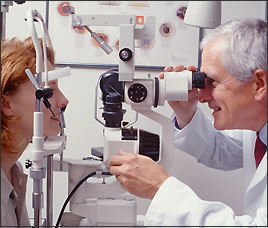Get The Facts
About Diabetic Eye Disease
What You Should Know About Diabetic Eye Disease
People with diabetes have a higher risk for eye disease as a complication of diabetes. We call this Diabetic Eye Disease. If you have diabetes, you are at risk for Diabetic Retinopathy, Cataracts and Glaucoma.
 What is Diabetic Retinopathy? What is Diabetic Retinopathy?
Diabetic Retinopathy is the most common diabetic eye disease and a leading cause of blindness in American adults under the age of 60. It is caused by changes in the blood vessels of the retina. In some people with diabetic retinopathy, blood vessels may swell and leak fluid. In other people, abnormal new blood vessels grow on the surface of the retina. The retina is the light-sensitive tissue at the back of the eye, and a healthy retina is necessary for good vision.
Who is At Risk for Diabetic Retinopathy?
All people with diabetes – both type 1 and type 2 – are at risk. That’s why everyone with diabetes should get a comprehensive dilated eye exam at least once a year. The longer you have diabetes, the more likely you will develop Diabetic Retinopathy. During pregnancy, Diabetic Retinopathy may be a problem for women with diabetes. To protect vision, every pregnant woman with diabetes should have a comprehensive eye exam as soon as possible. Your doctor may recommend additional exams during your pregnancy.
How to Protect Your Vision
-
If you have diabetes, get a comprehensive dilated eye exam at least once a year.
-
If you already have diabetic retinopathy, you may need an eye exam more often.
-
Control your blood sugar. Better control of blood sugar levels slows the onset and progression of retinopathy. The people with diabetes who kept their blood sugar levels as close to normal as possible, also had much less kidney and nerve disease. Better control also reduces the need for sight-saving laser surgery.
-
Studies have shown that controlling high blood pressure can reduce the risk of diabetic related vision loss.
|
Stages of Diabetic Retinopathy
Mild Non-proliferative Retinopathy. At this earliest stage, micro-aneurysms occur. They are small areas of balloon-like swelling in the retina’s tiny blood vessels.
-
Moderate / Severe Non-proliferative Retinopathy. This is a stage where the micro-aneurysms begin to leak fluid or exudates. This can impair a patient’s vision.
-
Severe Non-proliferative Retinopathy Many more blood vessels are blocked, depriving several areas of the retina with their blood supply. These areas of the retina send signals to the body to grow new blood vessels for nourishment.
-
Proliferative Retinopathy. As the disease progresses, some blood vessels that nourish the retina are blocked. At this stage, the signals sent by the retina for nourishment trigger the growth of new blood vessels. This condition is called proliferative retinopathy. These new blood vessels are abnormal and fragile. They grow along the retina and along the surface of the clear, vitreous gel that fills the inside of the eye. By themselves, these blood vessels do not cause symptoms or vision loss. However, they have thin, fragile walls. If they leak blood, severe vision loss and even blindness can result.
|
|
Prepare for Your Visit
For information regarding what to bring to your appointment, please visit our Patient Registration page.
Insurance and Payment
For important information regarding insurance and payment for your upcoming appointment and related insurance regulations, please visit our Insurance Information page.
Like us on  |
How is Diabetic Retinopathy Treated?
During the early stages of Diabetic Retinopathy, no treatment is needed, unless you have macular edema. To help prevent progression of diabetic retinopathy, people with diabetes should control their levels of blood sugar, blood pressure, and blood cholesterol. The treatment for macular edema is with focal laser treatment and/or anti-VEGF injections.
Proliferative retinopathy is treated with laser surgery. This procedure is called Pan Retinal Photo Coagulation (PRP). PRP laser treatment helps to shrink the abnormal blood vessels. Two or more sessions usually are required to complete treatment. Although you may notice some loss of your side vision, PRP treatment can save the rest of your sight. PRP laser treatment works better before the fragile, new blood vessels have started bleeding. That is why it is important to have regular, comprehensive dilated eye exams. Even if bleeding has started, PRP treatment may still be possible, depending on the amount of bleeding.
If the bleeding is severe, you may need a surgical procedure called vitrectomy, which removes blood from the center of your eye.
Associated Risks
As with any surgical procedure, there are risks associated with scatter laser treatment,and vitrectomy. Each eye in each situation is unique, and you should discuss the various options available to you to determine which of these options would be ideal for your situation. Any and all surgical procedures should be taken seriously. Our ophthalmologists want you to understand all of the benefits, pertinent risks, and potential complications of any procedure. Call us today to meet with one of our Board Certified Opthalmologists and get all of your questions answered. |
|






 What is Diabetic Retinopathy?
What is Diabetic Retinopathy?